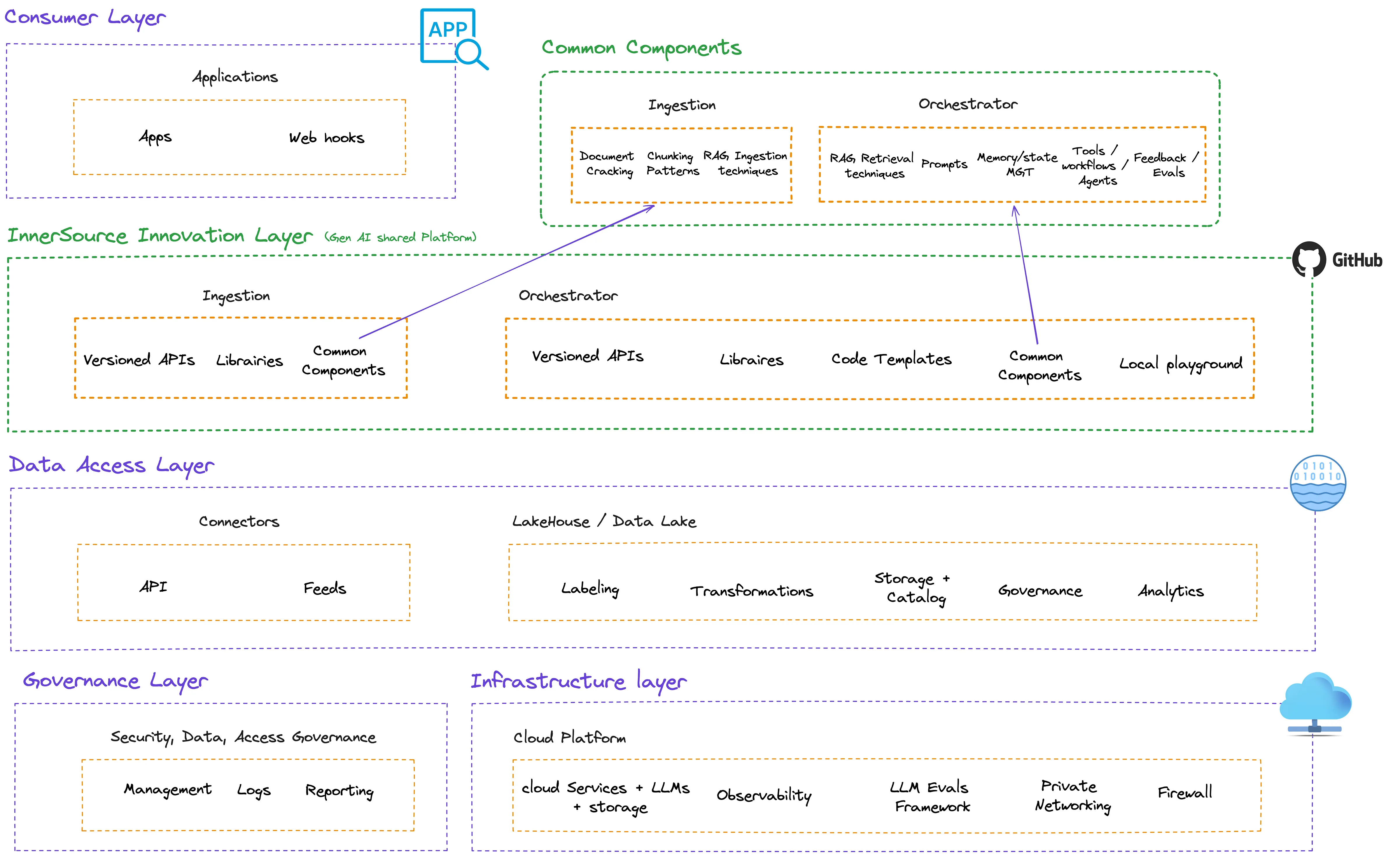Unlocking the Potential of Gen AI Innovation within the Enterprise through Inner Source

The rapid adoption of generative AI in businesses has highlighted the challenge of turning its potential into real business value, yet a promising path is emerging, inner source can be a key to unlocking enterprise wide Gen AI innovation.
In today’s rapidly evolving technological landscape, enterprises face immense pressure to innovate quickly and effectively. The advent of generative AI (Gen AI) has not only accelerated technology adoption cycles but also redefined how products move from proof of concept (POC) to production. While startups and small to medium sized enterprises (SMEs) are often celebrated for their agility, large corporations have unique advantages that, if leveraged properly, can position them at the forefront of innovation.
A successful innovation strategy hinges on adopting the right mindset. This involves:
-
Embracing a product mindset: Focusing on delivering tangible value and outcomes.
-
Applying the DFV framework: Assessing projects based on Desirability, Viability, and Feasibility, alongside strategic fit.
-
Data driven insights: Harnessing the enterprise’s assets and users to build insights and discovery.
-
Being technology forward when necessary: Recognising when technological advancements, like Gen AI, warrant a shift from traditional market driven approaches.
Conventional wisdom recommends selecting the right technology to address a problem, which I wholeheartedly agree with. Innovation teams sometimes force the adoption of a flashy technology that may not actually deliver value. However, there are instances of significant technological changes that necessitate a technology first approach to facilitate learning and maintain a competitive edge. In these situations, it’s crucial to collaborate with knowledgeable domain experts who focus on enhancing processes or workflows with technology experts. Working together, to open up access to Gen AI, from both a developer and user standpoint rather than in isolation, allows technology to be effectively integrated and utilised by domain experts, enabling them to unlock business value and test out hundreds of use cases much quicker than an isolated teams would.
With the right strategy in place setting up a corporate innovation incubator can have many advantages but are often constrained working within the constraints of a corporate operating structure for technical and business workflows. Often you want innovation teams to have openness to work outside these and sometimes are set up as separate entities to find value as it’s own entity.
A few ways enterprises can amplify their strengths in innovation can be:
-
Creating subsidiary ventures: Establishing smaller, agile units that operate with startup like freedom but with enterprise support.
-
Fostering internal innovation teams: Empowering dedicated groups to explore new technologies and drive change from within.
-
Implementing InnerSource practices: Utilising collaborative development models to leverage collective intelligence.
In many enterprise environments, maintaining innovation outside the traditional corporate firewall is usually insufficient. Enterprises must balance data security with the need for rapid technology deployment. Gen AI exemplifies this challenge, requiring secure data handling while enabling swift development and integration across business functions. Internal innovation teams, supported by Innersource practices, act as catalysts for shared innovation, ensuring that advancements are both secure and scalable.
InnerSource & Shared Platforms: The Enterprise’s Secret Weapon
InnerSource, the practice of applying open source principles within an organisation, emerges as a powerful catalyst for innovation. By fostering a culture of collaboration and shared knowledge, InnerSource enables enterprises to tap into their vast pools of internal expertise and accelerate development processes in a technology rapidly gaining application.
When applied to the right projects within the innovation lifecycle, InnerSource can:
-
Break down silos: Encouraging cross departmental collaboration enhances creativity and problem solving.
-
Improve code quality and reuse: Shared repositories reduce duplication of effort and promote best practices.
-
Accelerate time to market: Collaborative development shortens the path from POC to production.
-
Shared insights: Understand what works and how to build evaluation metrics into business domains collectively.
As of November 2024, generative AI workflows consist of numerous system components that are now standard across both small and large scale applications. As well as offering shared code this is paired with an API first platform, so many components can be accessed and integrated into applications without the need to host.
Key components of such platforms
-
Reusable RAG architecture: Ingestion pipelines, Chunking patterns, Retrieval, Re-ranking techniques.
-
Tools: Summarisation, Q&A, Document comparison, Classification, Natural language to knowledge bases querying (Unstructured, Structured databases), code generation and data analysis, other…
-
Workflows: Components for domain specific workflows and use cases that combine datasets and tools.
-
Agent architecture: orchestration, human in the loop, scheduling, communication between agents, etc…
-
Model Mgt & Evaluation framework: Model access, moderation logging, and management, Evals metrics to ensure the quality of use cases, applying ML/LLM Ops to CI/CD and delivering Gen ai in production
Facilitating the sharing of these components, via APIs, libraries, and implementation templates within an enterprise is essential for driving innovation. Large organisations typically deploy internal developer platforms to streamline infrastructure setups and enhance the developer experience. Similarly, establishing an internal Gen AI platform can standardise processes, enabling teams to rapidly implement and iterate on AI driven solutions.
Successful Gen AI platforms incorporate a mix of rapidly evolving elements and more stable infrastructure components:

Data Access Layer: The Foundation of Success
Likely the most important layer in the enterprise, but not the focus of this post, is the data layer. When deploying shared AI platforms, it’s crucial for enterprises to integrate a robust data access layer. This foundational element is essential for extracting meaningful insights, as it ensures that the platform has the right access to the necessary data.
Conclusion
Integrating Inner Source with Generative AI offers a powerful framework for enterprise innovation. By fostering a collaborative internal environment, leveraging deep domain knowledge, and adopting a strategic approach to technology adoption, large organisations can accelerate their innovation cycles and maintain a competitive edge.